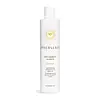What's inside
What's inside
 Key Ingredients
Key Ingredients

 Benefits
Benefits

 Concerns
Concerns

 Ingredients Side-by-side
Ingredients Side-by-side

Water
Skin ConditioningMaris Aqua
HumectantCocamidopropyl Hydroxysultaine
CleansingSodium Cocoyl Isethionate
CleansingCaprylyl/Capryl Glucoside
CleansingGlycerin
HumectantSodium Chloride
MaskingSodium Lauroyl Methyl Isethionate
CleansingButyrospermum Parkii Butter
Skin ConditioningCitrus Aurantium Dulcis Peel Oil
MaskingCitrus Medica Peel Oil
Eucalyptus Globulus Oil
Cucurbita Pepo
Skin ConditioningHydroxypropyltrimonium Honey
Hydrolyzed Quinoa
Skin ConditioningTrisodium Ethylenediamine Disuccinate
Sodium Benzoate
MaskingHydrolyzed Rice Protein
Skin ConditioningGuar Hydroxypropyltrimonium Chloride
Skin ConditioningPersea Gratissima Oil
Skin ConditioningOryza Sativa Bran Oil
EmollientCamellia Sinensis Leaf Extract
AntimicrobialCucumis Sativus Fruit Extract
EmollientPersea Gratissima Fruit Extract
EmollientMangifera Indica Fruit Extract
Skin ConditioningWater, Maris Aqua, Cocamidopropyl Hydroxysultaine, Sodium Cocoyl Isethionate, Caprylyl/Capryl Glucoside, Glycerin, Sodium Chloride, Sodium Lauroyl Methyl Isethionate, Butyrospermum Parkii Butter, Citrus Aurantium Dulcis Peel Oil, Citrus Medica Peel Oil, Eucalyptus Globulus Oil, Cucurbita Pepo, Hydroxypropyltrimonium Honey, Hydrolyzed Quinoa, Trisodium Ethylenediamine Disuccinate, Sodium Benzoate, Hydrolyzed Rice Protein, Guar Hydroxypropyltrimonium Chloride, Persea Gratissima Oil, Oryza Sativa Bran Oil, Camellia Sinensis Leaf Extract, Cucumis Sativus Fruit Extract, Persea Gratissima Fruit Extract, Mangifera Indica Fruit Extract
Water
Skin ConditioningSodium Coco-Sulfate
CleansingCoco-Glucoside
CleansingGlycerin
HumectantSodium Cocoyl Isethionate
CleansingLauryl Hydroxysultaine
CleansingCitric Acid
BufferingSodium Chloride
MaskingInulin
Skin ConditioningGlyceryl Oleate
EmollientSodium Benzoate
MaskingPotassium Sorbate
PreservativePanthenol
Skin ConditioningVitis Vinifera Seed Oil
EmollientGuar Hydroxypropyltrimonium Chloride
Skin ConditioningAvena Sativa Kernel Extract
AbrasiveHydrolyzed Soy Protein
HumectantWater, Sodium Coco-Sulfate, Coco-Glucoside, Glycerin, Sodium Cocoyl Isethionate, Lauryl Hydroxysultaine, Citric Acid, Sodium Chloride, Inulin, Glyceryl Oleate, Sodium Benzoate, Potassium Sorbate, Panthenol, Vitis Vinifera Seed Oil, Guar Hydroxypropyltrimonium Chloride, Avena Sativa Kernel Extract, Hydrolyzed Soy Protein
Ingredients Explained
These ingredients are found in both products.
Ingredients higher up in an ingredient list are typically present in a larger amount.
Glycerin is already naturally found in your skin. It helps moisturize and protect your skin.
A study from 2016 found glycerin to be more effective as a humectant than AHAs and hyaluronic acid.
As a humectant, it helps the skin stay hydrated by pulling moisture to your skin. The low molecular weight of glycerin allows it to pull moisture into the deeper layers of your skin.
Hydrated skin improves your skin barrier; Your skin barrier helps protect against irritants and bacteria.
Glycerin has also been found to have antimicrobial and antiviral properties. Due to these properties, glycerin is often used in wound and burn treatments.
In cosmetics, glycerin is usually derived from plants such as soybean or palm. However, it can also be sourced from animals, such as tallow or animal fat.
This ingredient is organic, colorless, odorless, and non-toxic.
Glycerin is the name for this ingredient in American English. British English uses Glycerol/Glycerine.
Learn more about GlycerinThis ingredient is derived from guar gum.
It is a conditioning ingredient, meaning it helps soften skin and hair.
Sodium Benzoate is a preservative. It's used in both cosmetic and food products to inhibit the growth of mold and bacteria. It is typically produced synthetically.
Both the US FDA and EU Health Committee have approved the use of sodium benzoate. In the US, levels of 0.1% (of the total product) are allowed.
Sodium benzoate works as a preservative by inhibiting the growth of bacteria inside of cells. It prevents the cell from fermenting a type of sugar using an enzyme called phosphofructokinase.
It is the salt of benzoic acid. Foods containing sodium benzoate include soda, salad dressings, condiments, fruit juices, wines, and snack foods.
Studies for using ascorbic acid and sodium benzoate in cosmetics are lacking, especially in skincare routines with multiple steps.
We always recommend speaking with a professional, such as a dermatologist, if you have any concerns.
Learn more about Sodium BenzoateChances are, you eat sodium chloride every day. Sodium Chloride is also known as table salt.
This ingredient has many purposes in skincare: thickener, emulsifier, and exfoliator.
You'll most likely find this ingredient in cleansers where it is used to create a gel-like texture. As an emulsifier, it also prevents ingredients from separating.
There is much debate on whether this ingredient is comedogenic. The short answer - comedogenic ratings don't tell the whole story. Learn more about comegodenic ratings here.
The concensus about this ingredient causing acne seems to be divided. Research is needed to understand if this ingredient does cause acne.
Scrubs may use salt as the primary exfoliating ingredient.
Learn more about Sodium ChlorideSodium cocoyl isethionate is a natural ingredient from coconut oil. It is an ultra gentle cleanser that gives a nice foam without drying the skin or impacting the skin barrier.
The amount of foam created depends on the amount of sodium cocoyl isethionate used in the product.
This ingredient also helps improve the spreadability of a product.
Learn more about Sodium Cocoyl IsethionateWater. It's the most common cosmetic ingredient of all. You'll usually see it at the top of ingredient lists, meaning that it makes up the largest part of the product.
So why is it so popular? Water most often acts as a solvent - this means that it helps dissolve other ingredients into the formulation.
You'll also recognize water as that liquid we all need to stay alive. If you see this, drink a glass of water. Stay hydrated!
Learn more about Water